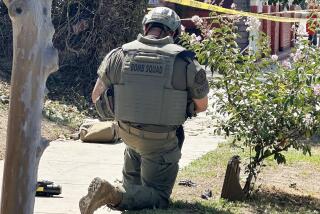Old Artillery Rounds Found at Field Lab
- Share via
SIMI VALLEY — Three 30-year-old artillery rounds have been unearthed at Rocketdyne’s Santa Susana Field Laboratory property, leaving neighbors of the aerospace giant concerned despite assurances by company officials that the munitions are small and innocuous.
Half a dozen employees, working on a $55-million project to clean up chemical and nuclear contaminants, found the cylindrical shells in a ravine beneath 20 feet of dense scrub brush and rocky dirt, Rocketdyne spokesman Dan Beck confirmed Friday.
The munitions were discovered Wednesday afternoon in the Happy Valley area of the 2,668-acre, open-air field lab, about two miles from expensive homes in Bell Canyon, he said.
“The best we can tell is they’re probably parts for some sort of ordnance that we were testing the engines, or motors, for,” Beck said. “We don’t know if they are live rounds or rounds with filler--dummy rounds. . . . They’re nothing real nasty like chemical weapons. They are not nuclear.”
Company officials may find out what is in the rounds after weapons experts detonate them Monday in a nearby bunker, Beck said.
The two smaller shells were corroded almost beyond recognition. None bore serial numbers or identifying marks.
Although company officials described the rounds as innocuous when handled by experts, one critic said he was concerned that the shells were carelessly dumped and that others might be found.
“Why is there unexploded ordnance on the property? Are there more?” asked Daniel Hirsch, a member of a panel overseeing health studies of workers.
Hirsch said he had never heard of military testing on “the Hill.”
“I’ve followed this for 20 years, and I know of nuclear activity, rocket tests, I even know about laser tests,” he said. “I’ve never heard of military ordnance. Finding it in a contaminated area . . . makes it seem like they’re not particularly careful disposing of things that are hazardous.”
X-rays show that the munitions have triggering devices, but it is impossible to tell whether they are filled with explosives or filler, such as grain, Beck said.
Detonation will occur in a low-slung “ordnance bay” that has 8-foot-thick reinforced concrete walls. Paired with another explosive, each device will be smothered with sandbags and blown up by remote control.
Beck said neighbors are in no danger.
More to Read
Sign up for Essential California
The most important California stories and recommendations in your inbox every morning.
You may occasionally receive promotional content from the Los Angeles Times.













